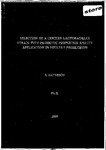SELECTION OF A CHICKEN LACTOBACILLUS STRAIN WITH PROBIOTIC PROPERTIES AND ITS APPLICATION IN POULTRY PRODUCTION
| dc.contributor.supervisor | Brooks, Pr. Peter | |
| dc.contributor.author | SAWIDOU, SOUMELA | |
| dc.contributor.other | Faculty of Science and Engineering | en_US |
| dc.date.accessioned | 2012-08-10T11:22:01Z | |
| dc.date.available | 2012-08-10T11:22:01Z | |
| dc.date.issued | 2009 | |
| dc.identifier | Not available | en_US |
| dc.identifier.uri | http://hdl.handle.net/10026.1/1141 | |
| dc.description.abstract |
One hundred and eleven lactic acid bacteria, of chicken origin, were tested for possible probiotic properties. One organism, Lactobacillus salivarius Salivarius NCIMB 41606 {Lact. "Salivarius) showed rapid autoaggregation ability, maximum co-aggregation ability with enteropathogens, tolerance to acidic pH and bile salts of the chicken Gl-tract, very good antagonistic activity against several enteropathogens and good adhesive capacity to chicken epithelial cells. It was also found to survive in water for 24h and produce fermented feed, of low pH (<Q.4) and containing >150 mmol L-1 lactic acid after 24h fermentation at 30°C. This organism was selected as a candidate that could be used in vivo as a chicken probiotic. Lact. Salivarius NCIMB 41606 was assessed for its efficacy in reducing the shedding of Salmonella enterica Typhimurium Sal 1344 nal' in one day old chicks and during their 40 day development, in vivo. The overall percentage of Salmonella shedding chickens was significantly greater in the probiotic and acid unsupplemented control birds (CON) at 93% than in the other three supplemented treatments. The overall percentage of Salmonella shedding chickens for the group fed moist feed, fermented with Lact. Salivarius NCIMB 41606 (FMF) was significantly (P<0.05) lower (48%) than for the group provided with Lact. Salivarius via water (WAT) (81%) and the probiotic free group, fed acidified moist feed (AMF) containing the same amount of lactic acid as FMF birds (75%). The overall mean faecal lactobacilli counts from chickens fed FMF were also significantly higher (P<0.05) at 8.35 log10 cfu/g than the three other groups which were 7.78, 7.99 and 7.67 logio cfu g-1 for WAT, AMF and CON respectively. The overall mean Salmonella counts were significantly higher in the CON chicks at 5.35 logio CFU gr"^ than WAT, FMF and AMF which had respective Salmonella counts of 4.95, 4.66 and 4.39 logio CFU gr""". At 26 day post mortem the FMF group had significantly (P<0.05) lower ileal Salmonella counts (1.08 logio CFU ml-1) compared to the CON (6.61 logic CFU ml*1) and AMF groups ( 6.10 logio CFU mP) and FMF and WAT group had significantly (P<0.05) lower caecal Salmonella counts than the CON group (1.05, 1.20 and 5.03 logio CFU ml-1 respectively). There were no significant differences between the treatments, for 40 days post mortem. Determination of microflora of the caecum by cultivation on selective media showed significantly higher Lactobacillus counts for FMF group than for the CON and the WAT group (8.87, 8.28 and 8.12 CFU ml""*). Molecular-based analysis of ileal microbial species diversity demonstrated that treatments with Lact. Salivarius (WAT and FMF) showed high similarity between them (53.9%). FMF produced using Lact. Salivarius NCIMB 41606, is suggested as an effective means of controlling S. typhimurium infection to poultry. | en_US |
| dc.language.iso | en | en_US |
| dc.publisher | University of Plymouth | en_US |
| dc.title | SELECTION OF A CHICKEN LACTOBACILLUS STRAIN WITH PROBIOTIC PROPERTIES AND ITS APPLICATION IN POULTRY PRODUCTION | en_US |
| dc.type | Thesis | |
| plymouth.version | Full version | en_US |
| dc.identifier.doi | http://dx.doi.org/10.24382/4754 |
Files in this item
This item appears in the following Collection(s)
-
01 Research Theses Main Collection
Research Theses Main


